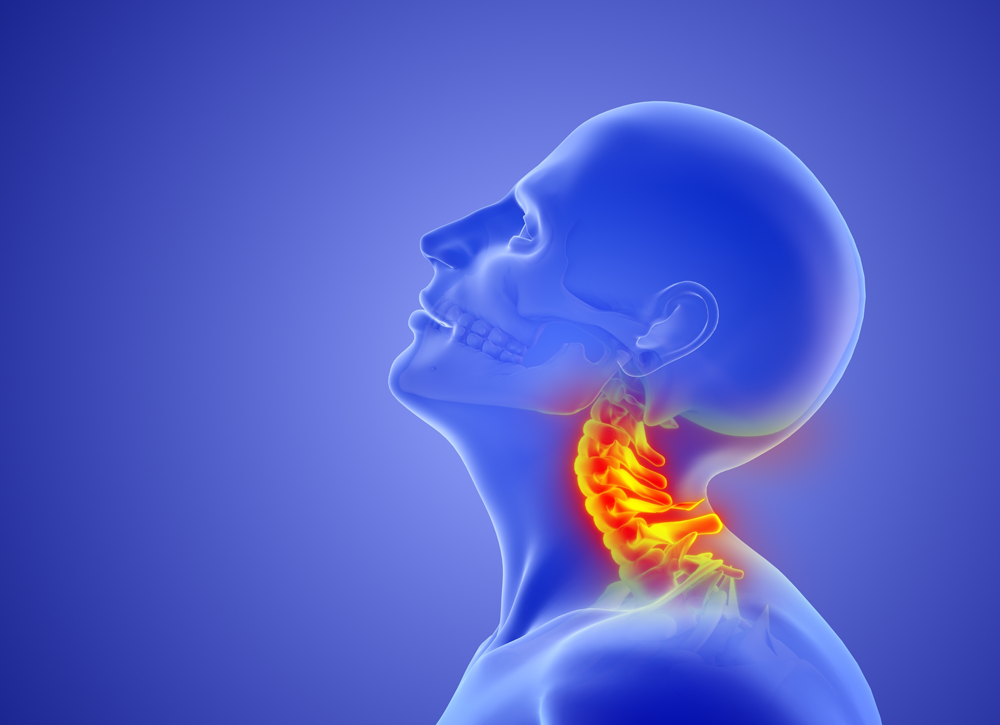Accurate diagnosis and evidence-based care for neck injuries after trauma

Whiplash syndrome is a neck injury caused by a rapid acceleration–deceleration motion, most commonly associated with motor vehicle accidents. As a clinical entity, it presents many challenges to the clinician due to multiple factors. While many patients recover with appropriate care, others may experience persistent neck pain, stiffness, headaches, or neurological symptoms if the condition is not properly evaluated and managed.
At Virginia Spine Specialists, we take a modern, structured approach to whiplash—focusing on early diagnosis, appropriate mobilization, and personalized treatment to support recovery and prevent chronic symptoms.
Understanding Whiplash Syndrome
What Is Whiplash?
Whiplash occurs when sudden force causes the neck to move violently forward and backward, stressing the muscles, ligaments, discs, and joints of the cervical spine. Although rear-end car collisions are the most common cause, whiplash can also result from:
- Side-impact crashes
- Sports injuries
- Falls or diving accidents
The injury may involve soft tissues, spinal joints, or discs—and in more severe cases, nerves or bone.
Whiplash syndrome is a hyperextension injury of the cervical spine that is commonly associated with motor vehicle crashes. As a clinical entity, it presents many chalenges to the clinician due to multiple factors. Roughly 13 million motor vehicle crashes occur annually—of these 1 million cause whiplash injuries. The incidence of insurance claims for whiplash is roughly 1 per 1000 population per year. There is controversy regarding the pathophysiology, evaluation, and treatment strategies for this syndrome. Unfortunately, this lack of clear guidelines may lead to misdiag- nosis and suboptimal management of patients afflicted with the whiplash syndrome. This article seeks to present a review of the topic of whiplash along with some treatment guide- lines.
Background and Definition
To establish diagnosis, management, and treatment guidelines, the Quebec automobile insurance society requested formulation the Quebec Task Force (QTF) on Whiplash- associated disorders. Their report, published in 1995, critically evaluated research data available on the subject and made diagnosis and treatment recommendations. They defined the term whiplash as the following:
“Whiplash is an acceleration–deceleration mechanism of energy transfer to the neck. It may result from rear-end or side-impact motor vehicle collisions, but can also occur during diving or other mishaps. The impact may result in bony or soft-tissue injuries (whiplash injury), which in turn may lead to a variety of clinical manifestations.”
Whiplash-associated disorders is the description of clinical disorders associated with the injury. They are classified according to the severity of symptoms and presence of musculoskeletal and neurologic signs. The clinical classification of whiplash on clinical–anatomic axis has five grades (0 to IV) with grade 0 patients being asymptomatic. Grade I includes patients with complaints of neck pain, stiffness, or neck tenderness in the absence of any other physical signs. Grade II whiplash-associated disorders include patients with neck complaints and clinical signs of musculoskeletal disorder (eg, decreased range of motion and point tenderness). Grade III includes patients with neck complaints and neurological signs (including decreased deep tendon reflexes, weakness, or sensory deficits). Grade IV includes patients with spinal cord injury or fracture/dislocation of the bony elements. The classification system is primarily designed to facilitate management of Grade I, II, and III whiplash-associated disorders.
Pathophysiology
Hyperextension of the neck is thought to be the primary mechanism of injury for majority of whiplash-associated disorders. The acceleration–deceleration forces are thought to produce extension of the lower cervical vertebrae without translational movement. This movement can result in a spectrum of musculo-ligamentous and disk injuries, separation of the anterior end of the vertebral bodies, and compression of the zygapophysial joints posteriorly. The resulting injuries include disruption of the anterior longitudinal ligament (leading to hemorrhage beneath the prevertebral fascia), stretching of the posterior longitudinal ligament, fracture of zygapophysial joint, and tears of annulus fibrosis. There has been some interest in investigating the utility of functional imaging in diagnosis of whiplash-associated disorders, but the data are conflicting. The basis of these investigations is the observation that there is an abnormality of glucose metabo- lism in whiplash brain. Bilateral hypometabolism and hypoperfusion in the parieto-occipital region of patients with whiplash has been observed. Selective blocks of cervical zygapophysial joints have some diagnostic benefit in late whiplash and chronic neck pain patients.
Symptoms
Symptoms may appear immediately or develop hours to days after injury and can include:
- Neck pain and stiffness
- Headaches, often starting at the base of the skull
- Shoulder or upper back pain
- Reduced range of motion
- Arm pain, numbness, or tingling
- Dizziness or difficulty concentrating
The severity of symptoms does not always correlate with the apparent severity of the accident, which is why careful evaluation is important.
Modern Approach to Diagnosis
Whiplash is a clinical diagnosis, supported by physical examination and imaging when appropriate. Advanced imaging may be used to:
- Rule out fractures or instability
- Identify disc or joint injury
- Evaluate nerve involvement
At Virginia Spine Specialists, the focus is on identifying treatable pain generators while avoiding unnecessary testing or interventions.
Evidence Based Treatment Options
Before the QTF study and subsequent reviews, there was significant disparity in standards and practices for treatment of whiplash-associated disorders. Some authors prescribed a cervical collar and prolonged bed rest for patients with neck pain associated with whiplash; this strategy showed no clinical benefit in any scientifically controlled rigorous studies. However, numerous studies have shown benefit of early return to normal daily activities and early mobilization. Patients with low-grade whiplash-associated disorders (Grades 0, 1) should be encouraged to return to their usual activities with no work restrictions. Early mobilization has been shown to be the most beneficial intervention in this group. Compared with the subset of patients instructed to use a neck collar and on sick leave, the group that returns to normal activity has a better outcome at 6 months and 2 years. This is especially true for patients in whom the main complaint is neck pain, stiffness, or pain localization. Based on the findings of QTF, the following recommendations can be made regarding patients with whiplash-associated disorder:
- Activity: Patients should be encouraged to mobilize as soon as possible. Resuming normal activity may have the additional benefit of psychological reassurance for the patient. For patients with Grade II and III injuries, activity modifications can be made for unusual work environments.
- Neck Immobilization: The use of soft collars has not been shown to provide any therapeutic benefit and should be discouraged.
- Medications: Long-term outcome in low-grade WAD has not been shown to change with use of narcotics. Nonopioid analgesics and nonsteroidal anti-inflammatory drugs can be used in the early phase of Grades 0, I, and II whiplash-associated symptoms. For Grade III WAD, a short trial of narcotic medications may prove useful. No beneficial effect of muscle relaxants has been demonstrated.
- Bed Rest: Immobilization has not been shown to confer any benefit in any grade of WAD. For the purpose of neck rest, a short 4-day bed rest may be prescribed in Grade III WAD.
Manipulative and Physical Therapy: Spine manipulations for the purpose of pain relief and early immobilization performed by trained professionals may be beneficial. - Surgery: Low grades of WAD are not surgical pathologies. Progressive neurological deficit of intractable arm pain in Grade III WAD may respond to surgical intervention. Percutaneous radiofrequency neurotomy for cervical zygapophysial joint pain has been shown to provide symptomatic relief by targeting medial branches of cervical dorsal rami. The regeneration of these nerves causes recurrence of symptoms in about a year.
Early Mobilization & Conservative Care
Modern research shows that early, guided movement leads to better outcomes than prolonged immobilization. Treatment may include:
- Physical therapy focused on gentle mobilization and posture
- Pain-relieving and anti-inflammatory medications
- Activity modification rather than bed rest
- Patient education and reassurance
Prolonged use of cervical collars is generally discouraged, as it may delay recovery.
Advanced Pain Management (When Needed)
If symptoms persist or nerve involvement is suspected, additional treatments may be considered:
- Image-guided injections for targeted pain relief
- Interventional pain management techniques
- Short-term medication adjustments
Surgical Treatment (Rare and Highly Selective)
Whiplash is rarely a surgical condition. Surgery may be considered only when:
- There is clear nerve compression
- Progressive neurological deficits develop
- Structural instability is identified
These cases require careful, expert evaluation.
Prognosis & Recovery
Long-term persistence of whiplash symptoms has a correlation with the severity of symptoms on initial presentation. The presence of paresthesias (especially finger paresthesia) has been associated with longer persistence of symptoms. Past history of neck pain, early onset of symptoms, neck stiffness, neurological signs, and muscle spasms are associated with increased morbidity. There is a growing body of literature suggesting the chronic symptoms of whiplash may not be a direct consequence of the car crash (or other initial injury) but may be confounded by expectation of disability, family history, and attribution of preexisting symptoms to trauma. The elimination of compensation for pain and suf- fering has also been found to improve prognosis and to de- crease the incidence of chronic whiplash-associated symp- toms.
Whiplash and whiplash-associated disorder is a costly medical problem in the United States and is associated with significant burden to the patient in particular and society in general. The recognition and treatment of this problem can be challenging owing to its multitude of psychosocial and medicolegal associations. An astute clinician can be instru- mental in helping the patient make the quickest recovery to this essentially self-limiting disease.
Most patients with whiplash recover within weeks to months with appropriate care. Factors that may increase the risk of prolonged symptoms include:
- Severe initial pain
- Early neurological symptoms (such as arm numbness)
- Pre-existing neck problems
- Delayed or inappropriate treatment
Early, evidence-based management significantly improves the likelihood of full recovery.
Expert Evaluation for Whiplash Injuries with Dr. Mudit Sharma
As a board-certified neurosurgeon, Dr. Sharma specializes in diagnosing and treating complex cervical spine conditions, including traumatic neck injuries. Patients benefit from accurate diagnosis, conservative decision-making, and advanced care when needed.
Call (571) 921-4877 for an appointment.
Serving Manassas, Fredericksburg, Dulles and surrounding Northern Virginia communities
Frequently Asked Questions
Most cases are mild and improve with conservative care, but some patients require medical evaluation to rule out more serious injury.
Prolonged collar use is generally not recommended. Early, guided movement often leads to better recovery.
Many patients improve within weeks, though some may experience symptoms for several months.
If pain persists, worsens, or is accompanied by arm numbness, weakness, or headaches, specialist evaluation is recommended.

Toll Free: (855) 774-6334
Fax: (571) 208-0585
Conditions We Treat
Chronic Back Pain
Neck Pain
Arm Pain and/or Numbness
Leg Pain and/or Numbness
Herniated Disc – Lumbar and Cervical
Sacroiliac Joint (SI) Pain
Slipped Disc
Spinal Stenosis
Spinal Fractures
Whiplash Syndrome
Failed Back Surgery
Office Hours & Locations
Monday – Thursday: 8am – 4pm Friday: 8am – 2pm Loudoun County 24430 Stone Springs Blvd, Suite 250 Dulles, VA 20166 Spotsylvania County 4604 Spotsylvania Parkway, Suite 300 Fredericksburg, VA 22408 Prince William County 9625 Surveyor Ct. Suite 320 Manassas, VA 20110
